Champsocephalus esox, the pike icefish or northern icefish, is a species of marine ray-finned fish belonging to the family Channichthyidae, the crocodile icefishes.

The painted notie, or painted notothen, is a species of marine ray-finned fish, belonging to the family Nototheniidae, the notothens or cod icefishes. It is native to the Southern Ocean.
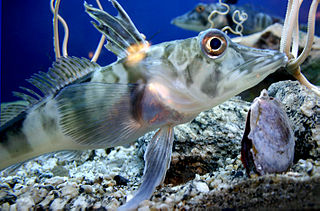
Chionodraco hamatus is a species of marine ray-finned fish belonging to the family Channichthyidae, the crocodile icefishes. It is found in the Southern Ocean.

Champsocephalus is a genus of marine ray-finned fish belonging to the family Channichthyidae, the crocodile icefishes. They are native to the Southern Ocean.

The blackfin icefish, also known as the Scotia Sea icefish, is a species of crocodile icefish belonging to the family Channichthyidae. The blackfin icefish belongs to Notothenioidei, a suborder of fishes that accounts for 90% of the fish fauna on the Antarctic continental shelf. Icefishes, also called white-blooded fishes, are a unique family in that they are the only known vertebrates to lack haemoglobin, making their blood oxygen carrying capacity just 10% that of other teleosts. Icefishes have translucent blood and creamy white gills.

Chaenodraco wilsoni, the spiny icefish, is a species of marine ray-finned fish belonging to the family Channichthyidae, the crocodile icefishes. It is native to the Southern Ocean. This species is the only known member of its genus. It is of minor interest to commercial fisheries.

Channichthys is a genus of marine ray-finned fish belonging to the family Channichthyidae, the crocodile icefishes. They are native to the Southern Ocean.
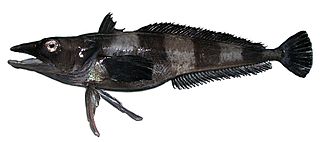
Chionobathyscus dewitti is a species of marine ray-finned fish belonging to the family Channichthyidae, the crocodile icefishes. This species is found in the Southern Ocean.

Chionodraco is a genus of marine ray-finned fish belonging to the family Channichthyidae, the crocodile icefishes. They are found in the Southern Ocean.

Cryodraco is a genus of marine ray-finned fish belonging to the family Channichthyidae, the crocodile icefishes. They are found in the Southern Ocean. While C. antarcticus has minor commercial importance, C. atkinsoni and C. pappenheimi are of no interest to commercial fisheries.

Dacodraco is a monotypic genus of marine ray-finned fish belonging to the family Channichthyidae, the crocodile icefishes, its only member is Dacodraco hunteri. This species is found in the Southern Ocean.

Jonah's icefish is a benthopelagic species of marine ray-finned fish belonging to the family Channichthyidae, the crocodile icefishes. It is the only member of the monotypic genus Neopagetopsis. It is found in the Southern Ocean at depths of from 20 to 900 metres. It has a circum-Antarctic distribution on the continental slope and continental shelf, with the northernmost records from the South Shetland and the South Orkney Islands.
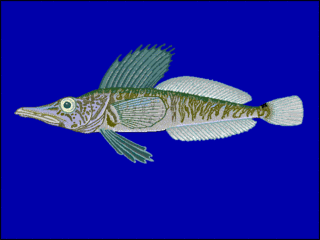
Pagetopsis is a genus of marine ray-finned fish belonging to the family Channichthyidae, the crocodile icefishes. The species in this genus are found in the Southern Ocean.
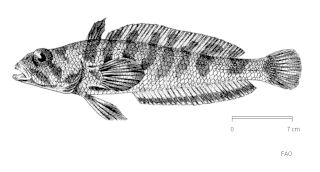
The grey rockcod, also known as the grey notothen, stripe-eyes notothen or stripe-eyed rockcod, is a species of marine ray-finned fish belonging to the family Nototheniidae, the notothens or cod icefishes. It is native to the Southern Ocean. The grey rockcod feeds mainly on macrozooplankton and is of minor importance to commercial fisheries. It is the only species in the genus Lepidonotothen.
Nototheniops is a genus of marine ray-finned fishes belonging to the family Nototheniidae, the notothens or cod icefishes. The species in this genus are native to the Southern Ocean.
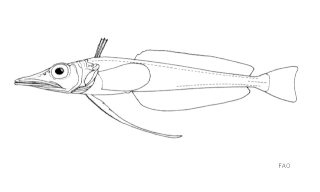
Cryodraco antarcticus, the long-fingered icefish, is a demersal species of marine ray-finned fish belonging to the family Channichthyidae, the crocodile icefishes. It occurs only in deep waters of the Southern Ocean.

Pagetopsis macropterus species of marine ray-finned fish belonging to the family Channichthyidae, the crocodile icefishes. This species is found in the Southern Ocean.
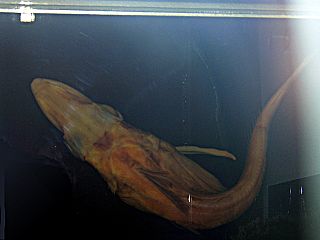
Chionodraco myersi, the Myers's icefish, is a species of marine ray-finned fish belonging to the family Channichthyidae, the crocodile icefishes. It is found in the Southern Ocean.

Cryodraco atkinsoni is a bathydemersal species of marine ray-finned fish belonging to the family Channichthyidae, the crocodile icefishes. It is endemic to the waters of the eastern part of the Southern Ocean.

Gobionotothen gibberifrons, the humped rockcod or the humphead notothen, is a species of marine ray-finned fish belonging to the family Nototheniidae, the notothens or cod icefishes. It is native to the islands of the Scotia Arc, the northern part of the Antarctic Peninsula, and Heard Island in the Southern Ocean. This species inhabits depths of 6-429 m, but is most abundant at depths of 100-400 m, at least around Elephant Island.
















